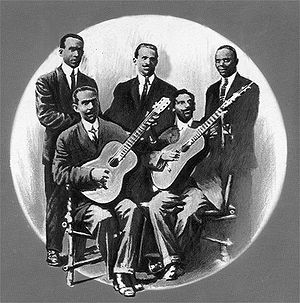Pepe Sánchez (trova)
José "Pepe" Sánchez (Santiago de Cuba, 19 March 1856 – 3 January 1918), was a Cuban musician, singer and composer. He is known as the father of the trova style and the creator of the Cuban bolero.[1]

with three singers (standing)
Sánchez was originally a tailor, and later the co-owner of a copper mine, and the representative in Santiago de Cuba of a cloth manufacturer in Kingston, Jamaica. He moved in upper and middle class circles in Santiago despite being a mulatto; his work as a businessman and musician brought him recognition and acceptance.[2]
Pepe had some experience in bufo theatre, but had no formal training in music. With remarkable natural talent, he composed numbers in his head and never wrote them down. As a result, most of these numbers are now lost for ever, though some two dozen or so survive because friends and disciples wrote them down. His first bolero, Tristezas, is still remembered today. He also created advertisement jingles before radio was born.[3] He was the model and teacher for the great trovadores who followed him: Sindo Garay, Rosendo Ruiz, Manuel Corona and Alberto Villalón.[4]
Other works of note are Pobre artista, Rosa I, II and III, Cuando oí la expressión de tu canto, Cuba, mi patria querida, Caridad, Esperanza, Naturaleza and Himno a Maceo.
There is one modern recording of his music:
- La música de Pepe Sánchez. Siboney LD–315
References

creator of the Cuban bolero;
mentor of the early trovadors
- ^ Orovio, Helio 1995. El bolero latino. La Habana.
- ^ Cañizares, Dulcila 1995. La trova tradicional. 2nd ed, La Habana. p19
- ^ Sublette, Ned 2004. Cuba and its music: from the first drums to the mambo. Chicago. p253 gives a verse on Cola marca Palma Real
- ^ Orovio, Helio 2004. Cuban music from A to Z. p195.
- Articles with short description
- Short description is different from Wikidata
- Articles with ISNI identifiers
- Articles with VIAF identifiers
- Articles with GND identifiers
- Articles with LCCN identifiers
- 1856 births
- 1918 deaths
- Cuban male singer-songwriters
- Cuban singer-songwriters
- Cuban male guitarists
- 19th-century Cuban male singers
- 20th-century Cuban male singers
- 19th-century guitarists
- People from Spanish Cuba